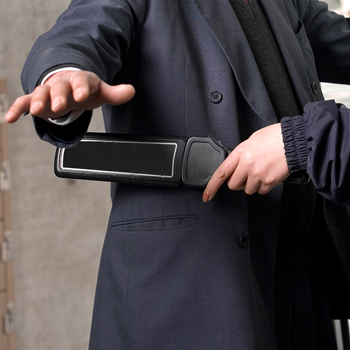“Daddy, hurry up we are going to miss our flight!” your six-year-old daughter shouts as she runs through the airport entrance to the security line.
Smiling because you know the flight does not begin boarding for another 45 minutes, you play along.
You are headed to the Walt Disney World Resort in Florida for your annual family vacation. You always like to take your family away during the off season because it is the only time you get to spend with them.
“Slow down,” your wife says as her and your twelve-year-old son shuffle behind with their carry-on luggage. You laugh and continue running with your daughter.
Everyone finally catches up right around the corner from the TSA line.
Your daughter begins sharing how excited she is to meet every Disney character. You already know, though, because that is all she talked about during the 36-minute car ride to the airport.
Making the turn to the TSA, you stop dead in your tracks. You had no doubt that you would make it to your gate on time. Until now.
What you see ahead of you gives you butterflies.
The TSA line has over a hundred other travelers waiting to get through security. The TSA PreCheck line is as long as the other lines.
Anxiety takes over. You look at your wife. Then, you both look at your daughter. “Mickey,” she cries.
You are going to miss your flight. Now, what?
If you had a line like this at your property how would you look? Would you be booted from your position if this was a regular occurrence? Do you know how to overcome this problem?
TSA's Head of Security Loses Position Over Long Lines
According to a recent article released by USA Today, “The Transportation Security Administration's head of security was ousted this week because the agency is seeking a ‘different approach,’ and not because he did anything wrong, TSA Administrator Peter Neffenger said Tuesday.”
The article continues, “Kelly Hoggan was removed from his post amid an uproar over long lines at airport security checkpoints and intense scrutiny of bonus payments. Neffenger said he hoped to find another place ‘for Hoggan's talents’ within TSA.”
"I felt it was important to have a different approach going forward than we've had in the past. He said his goal was to gauge how to move travelers more efficiently through lines, rather than just faster,” Neffenger shared with USA Today.
Additional scrutiny arose during a May 12 hearing where, “Rep. Jason Chaffetz, R-Utah, slammed bonuses given to Hoggan, who was paid $181,500 per year. Chaffetz said Hoggan also received $90,000 in bonuses during a 13-month period that ended in November 2014.”
Here are our thoughts on this matter.
Yes, Hoggan might not have done anything wrong. However, what did he do right?
If you want to be booted like Kelly Hoggan, keep ‘taking’ from your organization while doing nothing to improve the problems of inefficiency that exist – a perfect example of the ‘cost of doing nothing.’
You must ask yourself:
- “Is this how I want to be remembered at my property?”
- “Is this my legacy?”
- “Do I expect solutions to appear or do I need to control these outcomes?”
- “Do I have the ability to fix this?”
Long security lines are a symptom of inefficiency for the TSA. What are your symptoms?
We urge you to understand the importance of not doing anything and not having efficient processes in place.
Having problems is OK. The real issue begins when you fail to recognize the symptoms your operation shows. It gets worse when you do nothing.
Your guests spend money to attend your events. You owe them a memorable experience.
The good news is, we know how you can achieve what Kelly Hoggan could not.
You need strategy, infrastructure, and technology. You need Proactive Operations.
You need it for reliable data to understand the inefficiencies throughout your operation. This helps you identify and correct issues before you ‘get the boot.’
Proactive Operations Generate Useful Data for Long-Lasting Improvement
The critical problem with TSA is their lack of Proactive Operations. As a leader, Kelly Hoggan missed the collective effort of all areas of his operation.
TSA Administrator, Peter Neffenger, is correct. They need to “move travelers more efficiently through lines, rather than just faster.”
To achieve this, they need a methodology, such as Proactive Operations, that results in the analytics required to improve, then optimize, their security operation.
You need a means to achieve efficiency. If you would like to learn more about Proactive Operations, we recommend that you read this article here.
Consider these questions, “Why do I need an efficient and proven strategy?” and “Why to put an infrastructure in place?” and “Why do I need to invest in progressive solutions?” They all have the same answer.
Do you know what it is?
Analytics.
Analytics is systematic. This means it is methodical, orderly, organized – efficient.
You need analytics to understand your operational effectiveness. You need to know how you are performing. You must know what is happening and why it is happening before you can fix it.
Analyzing data is how you improve future outcomes. Not doing so, well, that is how you get removed from your position.
Create an operation that leads to relevant information. Use the information to optimize your efficiency.
This is Proactive Operations.
Reliable Data Is the Only Type of Data You Can Afford
Measure and improve your operation using ‘reliable’ data.
- Response times to wet spills
- Deploying wheelchairs to guests
- Returning lost and found items to visitors
- Preventing equipment from breaking
- Shortening lines for patrons
How do you accomplish this?
Begin receiving, collecting, and documenting data that has a purpose. It is the information you need to use. Be proactive, not reactive.
As you know, doing nothing can cost more than taking control of your operational weaknesses.
Make the best operational decisions, and do not fear change, challenging the status quo, or making mistakes. You will find the solution as long as you apply effort.
Be proactive with the following questions.
How long does it take?
- Guests to make it through the turnstile lines?
- To receive a call?
- To dispatch an incident?
- Your responding staff to get on scene to the incident or problem?
- Your employees to mitigate the conflict and begin responding to the next?
In light of the TSA event, here is our perspective on moving guests through lines efficiently.
How long does it take guests to make it through the turnstile lines?
As you already know, this is where TSA needs improvement. It also applies to any industry.
You must manage the time it takes guests to enter your property, turnstiles, or security lines whether you oversee an airport or sporting events.
Take the time to nail down your efficiency. This is your first impression to guests.
Make it count.
In the end, these questions help you understand one major part of your operation’s effectiveness: Time.
- Get guests through lines faster
- Improve response times to issues and incidents
- Make fewer mistakes
Institute Proactive Operations for analytics that gives you the insight to put ‘time’ on your side.
Over to You
Implement Proactive Operations to guarantee efficiency throughout your organization. It will give you data you need to question your operation, dive deeper for answers, and elicit change that will enhance the guest experience at your property.
Don’t get booted. Be proactive.




